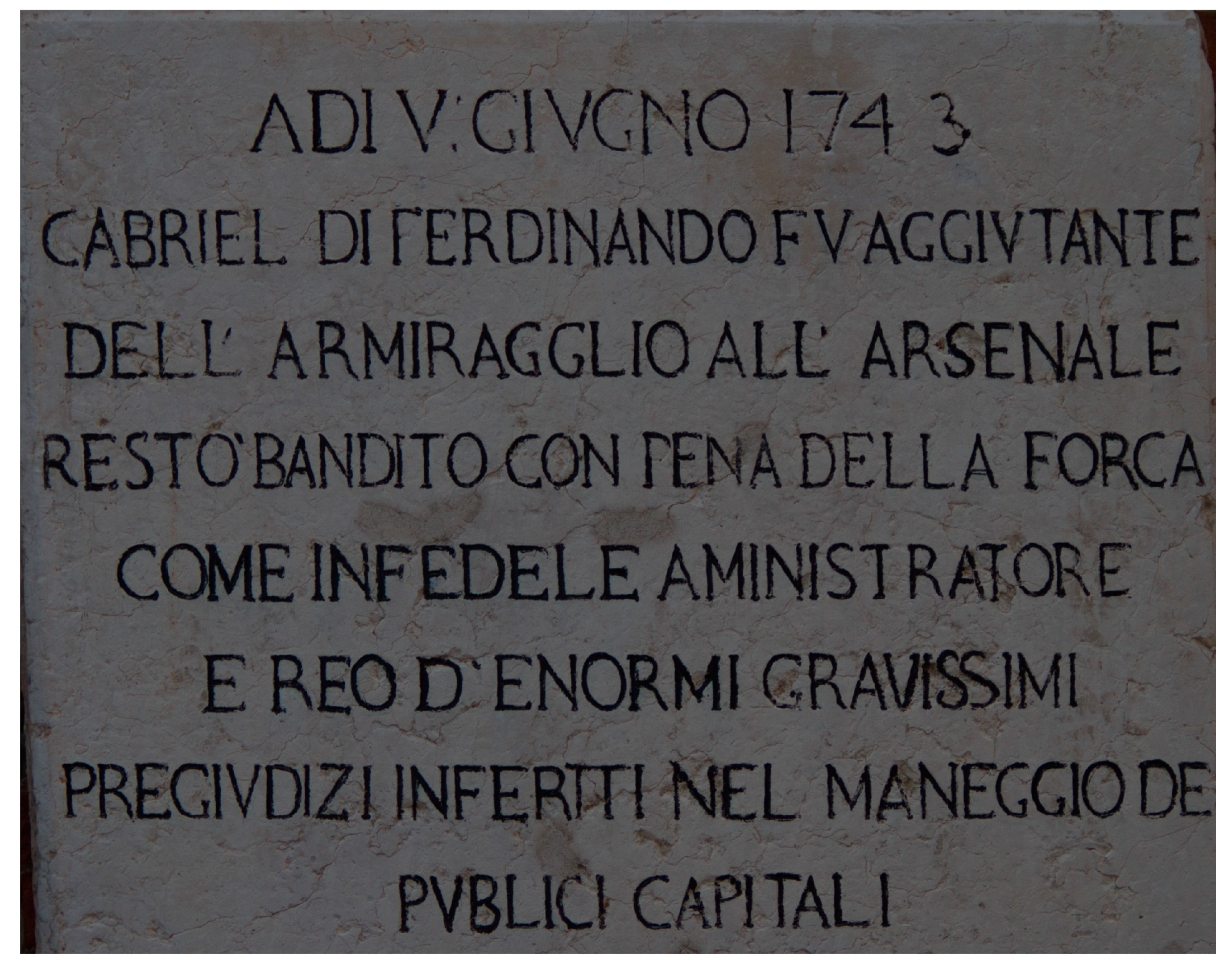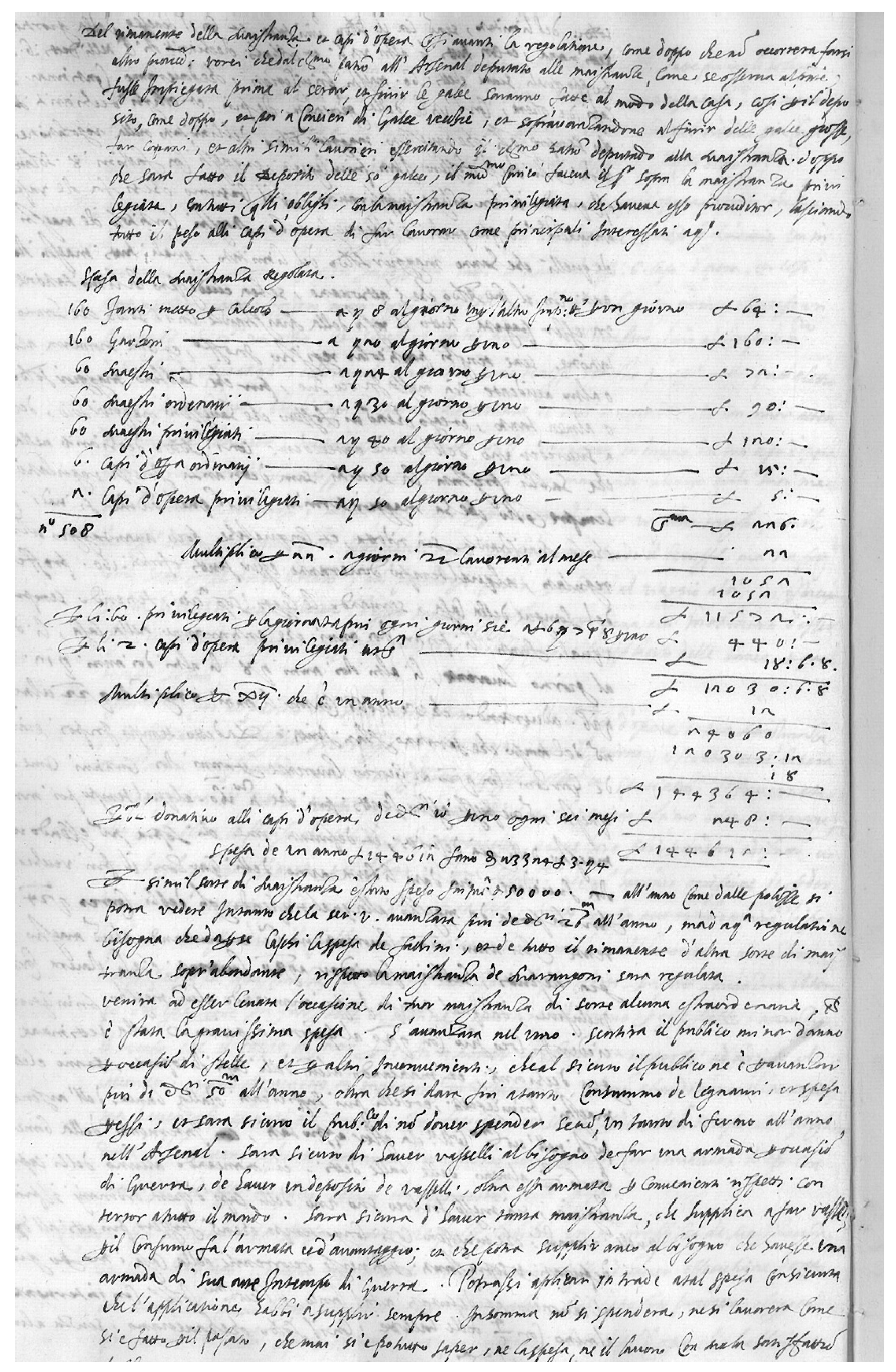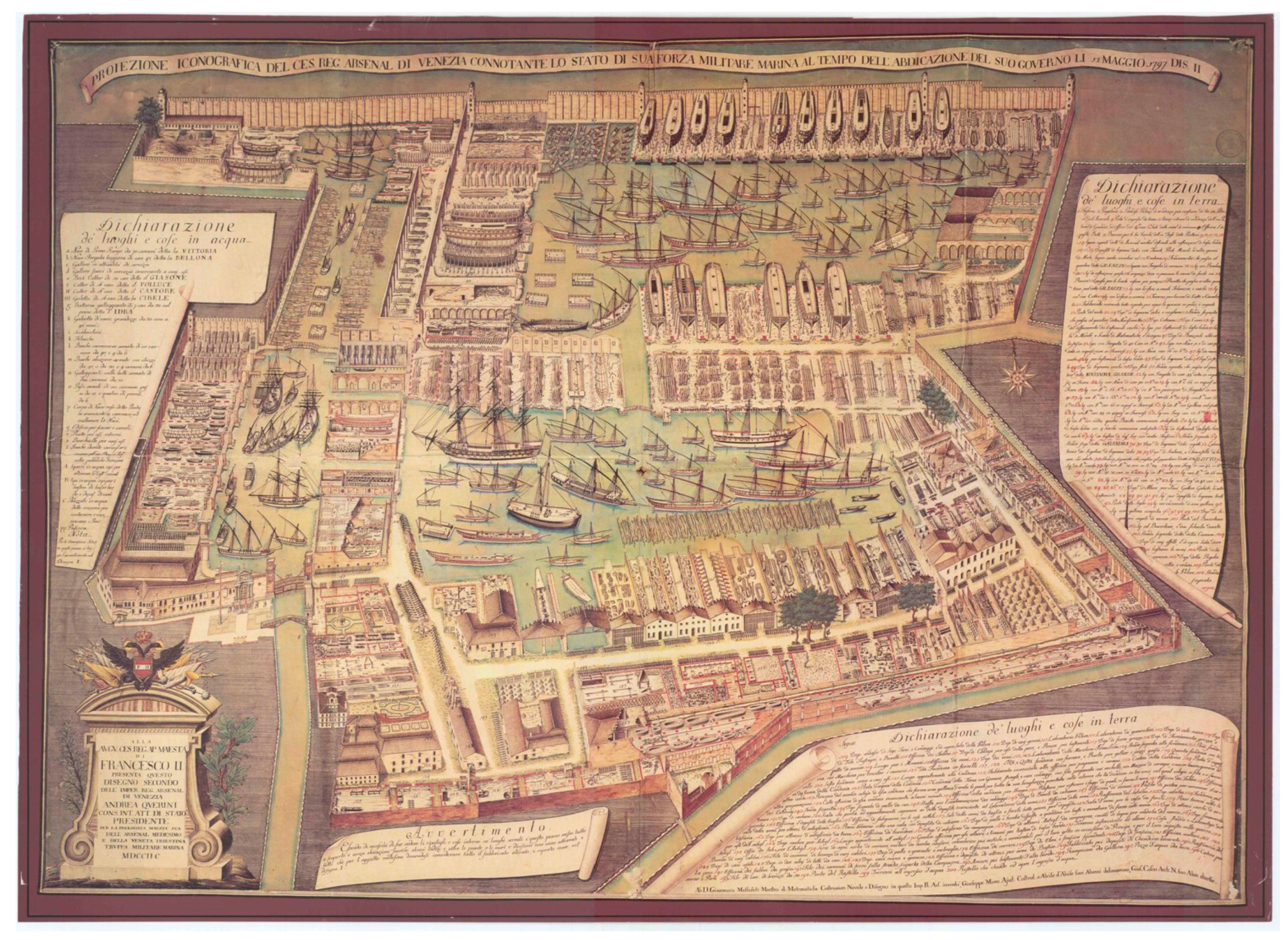History of Management and Stratigraphy of Organizing. The Venice Arsenal between Tangible and Intangible Heritage
Abstract
:1. The Venice Arsenal at the Crossroad of Several Historiographies
2. Methodological Notes
3. The Venice Arsenal and the History of Management
3.1. Managing: An Old Conundrum
3.2. Some Examples of Innovation in the Knowledge about Managing at the Venice Arsenal (1586/1633)
- “del modo di conservar li roveri” concerns matters that today we would define as pertaining to the logistics of raw materials, from acquisition to transport, and storage at the Arsenal;
- “della misura ordinaria delle galee” concerns the need to define single, common timber (“il sesto comune”) for the galleys produced in the Arsenal;
- “del modo di separar le galee nove dalle vecchie et accomodarle nei squeri con li legnami segati” deals essentially with what we would now define as the production layout, with the definition of areas for the production of new galleys and the maintenance of the old ones, and with adequate placement of the materials sorted by type;
- “delle maestranze et dell’ellettione a diversi carrichi” defines the composition of the work teams, with an early but precise example of organization of labor;
- “della ellettione delli reformatori et creation d’uno sopraintendente et conoscitor universal dell’arsenale” deals with the question of combined control over the entire complex, anticipating one of the most difficult questions of the whole modern organizational dilemma, namely the arrangement of power and responsibility within an organization.
3.3. Management and Accounting Historiographies: A Lack of Attention
4. Between Tangible and Intangible: Problems in Research and Narration
4.1. General Problems in the History of Management
4.2. Problems that are Specific to the Venice Arsenal
5. The Needs of Research, Documentation, and Presentation of the Intangible
6. Conclusions
Acknowledgments
Conflicts of Interest
References
- Nani Mocenigo, M. L’Arsenale di Venezia; Filippi: Roma, Italy, 1927. [Google Scholar]
- Lane, F. Venetian Ships and Shipbuilders of the Renaissance; Johns Hopkins Press: Baltimore, Spain, 1934. [Google Scholar]
- Lane, F. Le Navi di Venezia; Einaudi: Torino, Italy, 1969. [Google Scholar]
- Lane, F. Venice. A Maritime Republic; Baltimore; The Johns Hopkins University Press: Baltimore, Spain, 1973. [Google Scholar]
- Braudel, F. La Vita Economica di Venezia nel Secolo XVI. In La Civiltà Veneziana del Rinascimento; VV.AA.; Sansoni: Firenze, Italy, 1958. [Google Scholar]
- Braudel, F.; Jeannin, P.; Meuvret, J.; Romano, R. Le déclin de Venise au XVIIe siècle. In Aspetti e Cause Della Decadenza Economica Veneziana Nel Secolo XVII; Luzzato, G., Bognetti, G.P., Eds.; Istituto per la Collaborazione Culturale: Roma, Italy, 1961. [Google Scholar]
- Tenenti, A.; Tucci, U. (Eds.) Storia di Venezia, Vol. V, Il Rinascimento. Società ed Economia; Istituto dell’Enciclopedia Italiana: Roma, Italy, 1996. [Google Scholar]
- Bellavitis, G. L’Arsenale di Venezia. Storia di Una Grande Struttura Urbana; Cicero Editore: Venezia, Italy, 1983. [Google Scholar]
- Ventrice, P. L’Arsenale di Venezia e i cantieri navali della marina. Il Contributo Italiano Alla Storia del Pensiero. 2013. Available online: http://www.treccani.it/enciclopedia/l-arsenale-di-venezia-e-i-cantieri-navali-della-marina_%28Il-Contributo-italiano-alla-storia-del-Pensiero:-Tecnica%29/ (accessed on 23 February 2019).
- Ventrice, P. L’Arsenale di Venezia; Cierre Edizioni: Verona, Italy, 2009. [Google Scholar]
- Salvadori, A. L’Arsenal e l’industria navale. In Civiltà di Venezia, Vol. 2, Il Rinascimento; Perocco, G., Salvadori, A., Eds.; La Stamperia di Venezia Editrice: Venezia, Italy, 1987. [Google Scholar]
- Ferrari Bravo, M.; Lalosevic, I.; Marsetič, R.; Pavićević, R. Dalla Serenissima All’aquila Bicipite; Bioblion Edizioni: Milano, Italy, 2012. [Google Scholar]
- Casoni, G. Breve Storia dell’Arsenal di Venezia. In Venezia e Sue Lagune; Stabilimento Antonelli: Venezia, Italy, 1847; Volume 1. [Google Scholar]
- Concina, E. L’Arsenale della Repubblica di Venezia; Mondadori Electa: Milano, Italy, 1984. [Google Scholar]
- Vanore, M. (Ed.) HAULuP _ Heritage and Architecture of Urban Landscape under Production. Venezia Arsenale; Libellula Edizioni: Tricase, Italy, 2014. [Google Scholar]
- Pizzarello, U.; Fontana, V. Pietre e Legni Dell’arsenale di Venezia; L’Altra Riva: Venezia, Italy, 1983. [Google Scholar]
- Romano, R. Economic Aspects of the Construction of Warships in Venice in the Sixteenth Century. In Crisis and Change in the Venetian Economy in the Sixteenth and Seventeenth Centurie; Pullan, B., Ed.; Methuen and Co. Ltd.: London, UK, 1968; pp. 59–87. [Google Scholar]
- Forsellini, M. L’organizzazione economica dell’Arsenale di Venezia nella prima metà del Seicento. Arch. Veneto 1930, 7, 54–117. [Google Scholar]
- Caniato, G. L’ Arsenale: Maestranze e organizzazione del lavoro. In Storia di Venezia, Vol. V, II Rinascimento; Tucci, U., Tenenti, A., Eds.; Società ed Economia, Istituto della Enciclopedia Treccani: Roma, Italy, 1996. [Google Scholar]
- Davis, R. Costruttori di Navi a Venezia. Vita e Lavoro nell’Arsenale di Venezia, il più Grande Complesso Produttivo Preindustriale dell’età Moderna; Neri Pozza: Milan, Italy, 1997. [Google Scholar]
- Zan, L. Accounting and management discourse in protoindustrial settings: The Venice Arsenal in the turn of the XVI Century. Account. Bus. Res. 2004, 32, 145–175. [Google Scholar] [CrossRef]
- Zan, L.; Rossi, F.; Zambon, S. Il “Discorso del Maneggio”. Pratiche Gestionali e. Contabili all’Arsenale di Venezia, 1580–1643; Il Mulino: Bologna, Italy, 2006. [Google Scholar]
- Zambon, S.; Zan, L. Controlling expenditure, or the slow emergence of costing at the Venice Arsenal (1586–1633). Account. Bus. Financ. Hist. 2007, 17, 105–128. [Google Scholar] [CrossRef]
- Chirivi, R. L’ Arsenale di Venezia; Marsilio: Venezia, Italy, 1976. [Google Scholar]
- VV.AA. The Edge of the Arsenal; Maggioli: Venezia, Italy, 1997. [Google Scholar]
- D’agostino, R. Arsenale: Dallo Stato al Comune. In Il futuro dell’Arsenale di Venezia. Quale museo e Quale Accessibilità? Zan, L., Ed.; Cafoscarina: Venezia, Italy, 2019. [Google Scholar]
- Pastor, V. L’Arsenale di Venezia. Progetti Tentativo; Il Poligrafo: Padova, Italy, 2017. [Google Scholar]
- Gennaro, P.; Testi, G. Progetto Arsenale. Studi e Ricerche per l’Arsenale di Venezia; Cluva Università: Venezia, Italy, 1985. [Google Scholar]
- Gennaro, P.; Semerani, L. L’Arsenale Riordinato. Nuovi progetti per Venezia; Arsenale Editrice: Venezia, Italy, 1987. [Google Scholar]
- Lugato, D.; Ruol, M. (Eds.) L’Arsenale di Venezia. Una Metodologia per la Conservazione; Città Studi Edizioni: Milano, Italy, 1995. [Google Scholar]
- Pini, D. Castello e l’Arsenale: Serve proprio un ‘grande progetto’? In L’intorno dell’Arsenale; ILAUD: Urbino, Italy, 1999. [Google Scholar]
- Lombardi, G.; Aymonino, C.; Bandarin, F.; Bellavitis, G.; Brant, A.; Fontanari, E. L’Arsenale di Venezia e l’Expo 2000. Progetto di recupero dell’Arsenale di Venezia per attività temporanee e permanenti nello scenario dell’Esposizione Universale del 2000, Sintesi del Rapporto Finale; Venezia, Italy. 2000. Available online: http://sbd.iuav.it/sbda/mostraindici.php?&EW_D=NEW&EW_T=TF&EW_P=LS_EW&EW=008921&EW_INV=AA_CIA_000002051& (accessed on 15 April 2019).
- Chen, A.H.; Calzolaio, F. Progetti per L’arsenale di Venezia; Grafiche Biesse: Scorzè, Italy, 2001. [Google Scholar]
- AA.VV. Arsenale e/è Museo; Atti Della Prima Giornata di Studio per L’istituzione di un Museo Nazionale di Archeologia, Storia ed Etnografia Navale Nell’Arsenale di Venezia, 25 gennaio 2002, Quaderni Insula 11, 4. Available online: http://www.insula.it/index.php/quaderni (accessed on 15 April 2019).
- Dina, A. (Ed.) La Rinascita Dell’arsenale: La Fabbrica Che si Trasforma; Marsilio: Venezia, Italy, 2004. [Google Scholar]
- Città di Venezia. Documento Direttore per l’Arsenale di Venezia—2014; Direzione Patrimonio e Casa. Available online: http://arsenale.comune.venezia.it/? page_id=319 (accessed on 23 February 2019).
- Rossi, F. I quadri Direttivi dell’Arsenal. In Storia di Venezia, Vol. V, II Rinascimento; Tucci, U., Tenenti, A., Eds.; Società ed Economia, Istituto della Enciclopedia Treccani: Roma, Italy, 1996. [Google Scholar]
- Zan, L.; Deng, K. Micro foundations in the Great Divergence Debate: Opening up the perspective. Account. Hist. 2017. [Google Scholar] [CrossRef]
- Ari, B.; Zan, L. Shipbuilding & early forms of modern management. Comparing Venice & the Ottomans after Lepanto (1571). Paper Presented at the Workshop Strutture di organizzazione e modello di produzione. Mutazioni e Rappresentazioni. Storia e originalità, Ca’ Foscari, Venice, Italy, 27 November 2018. [Google Scholar]
- Zan, L.; Bonini Baraldi, S.; Lusiani, M.; Shoup, D.; Ferri, P.; Onofri, F. Managing Cultural Heritage. An International Research Perspective; Routledge: London, UK, 2015. [Google Scholar]
- Zan, L.; Yu, B.; Yu, J.; Yan, H. Heritage Sites in Contemporary China: Cultural Policies and Management Practices; Routledge: London, UK, 2018. [Google Scholar]
- Zan, L. (Ed.) Per un Futuro dell’Arsenale di Venezia; Cafoscarina: Venezia, Italy, 2018. [Google Scholar]
- Zan, L. (Ed.) Il Futuro Dell’arsenale di Venezia. Quale Museo e Quale Accessibilità? Cafoscarina: Venezia, Italy, 2019. [Google Scholar]
- Pettigrew, A. The Awakening Giant, Continuity and Change in ICI; Basil Blackwell: Oxford, UK, 1985. [Google Scholar]
- Zan, L. Complexity, anachronism and time-parochialism. Doing historical research from a (strategic) management background. Bus. Hist. 2016, 58, 571–596. [Google Scholar] [CrossRef]
- Verbix, Online Dictionary. Available online: http: //www.verbix.com/webverbix/English/manage.html (accessed on 23 February 2019).
- The Online Etymology Dictionary, 2010 Douglas Harper. Available online: https://www.etymonline.com/ (accessed on 23 February 2019).
- Ignoto. Libro Contenente il Maneggio Dell’esecuzione Testamentaria” Sopra la Peza Campo e Prato Regione Dell’eiretta Facciata dal fu sig. Prevosto Raso per Dotar Povere Figlie, Civico Museo Etnografico Ostana—Alta Valle Po.
- Treccani Online Dictionary. Available online: http://www.treccani.it/vocabolario/maneggio/ (accessed on 23 February 2019).
- Paciolo, L. Tractatus de’ Computis e et Scripturis, 1494. Ristampa Anagrafica Dell’edizione del 1978 della Tip. E Lit; Camilla e Bertolero, Cacucci editore: Roma, Italy, 1987. [Google Scholar]
- Drachio, B. Ricordi Intorno la Casa dell’Arsenale, 1586. A.S.Ve, Patroni e Provevditori all’Arsenal, b. 533. Già tra le Carte di Giacomo Contarini; cfr. A.S.Ve, Sala di studio, Indice 311/4. Riprodotto in appendice documentale in Zan et al. 2006; pp. 239–264. [Google Scholar]
- Tadini, B. Scrittura de Messer Bortolomio Tadini, 1593, 12 Maggio. A.S.Ve, Patroni e Provveditori all’Arsenal, b. 533; Reproduced in the documentary appendix in Zan et al. 2006; pp. 265–275. [Google Scholar]
- Tadini, B. 1594, Scrittura Presentata per Messer Bortolamio Tadini, Rasonato all’Arsenal Nell’eccellentissimo Collegio, adì 19 Zugno 1594. A.S.Ve, Patroni e Provveditori all’Arsenal, b. 533; Reproduced in the documentary appendix in Zan et al. 2006; pp. 276–280. [Google Scholar]
- Molin, A. Relatione del Nobil Homo Ser Alvise Molin, Savio agli Ordini, Letta Nell’eccellentissimo Senato. 1633. A.S.Ve, Collegio, Relazioni, b. 57; Reproduced in the documentary appendix in Zan et al. 2006; pp. 345–366. [Google Scholar]
- Ansoff, H. Implanting Strategic Management; Prentice-Hall: Englewood Cliffs, NJ, USA, 1984. [Google Scholar]
- Pfeffer, J. Renaissance and Renewal in Management Studies: Relevance Regained. Eur. Manag. Rev. 2009, 6, 141–148. [Google Scholar] [CrossRef]
- Zan, L. Toward a history of accounting histories. Eur. Account. Rev. 2004, 3, 255–307. [Google Scholar] [CrossRef]
- ThoughtCo, History of Accounting from Ancient Times to Today. The Medieval and Renaissance Revolution of Bookkeeping. Available online: https://www.thoughtco.com/history-of-accounting-1991228 (accessed on 23 February 2019).
- Johnson, H.; Kaplan, R. Relevance Lost: The Rise and Fall of Management Accounting; Harvard Business School Press: Boston, MA, USA, 1987. [Google Scholar]
- Chandler, A.D. La Mano Visibile. La Rivoluzione Manageriale Nell’economia Americana; ed orig 1977, Cambridge; Franco Angeli: Milan, Italy, 1981. [Google Scholar]
- Chandler, A.D. Gli Stati Uniti: L’evoluzione dell’impresa. In Evoluzione della Grande Impresa e Management; Payne, P.L., Kocka, J., Yamamura, K., Chandler, A.D., Eds.; ed orig Cambridge; Einaudi: Torino, Italy, 1986. [Google Scholar]
- March, J. Decisions and Organisations; Basil Blackwell: Oxford, UK, 1988. [Google Scholar]
- Czarniawska, B. Organizing: How to study it and how to write about it. Qual. Res. Organ. Manag. 2008, 3, 4–20. [Google Scholar] [CrossRef]
- Menichelli, C. Sviluppo e trasformazione dell’Arsenale di Venezia in funzione della produzione navale. In Arsenale di Venezia. Progetti e Destino; Bosio, M., Fornasiero, T., Gambelli, V., Eds.; Incipit Editore: Conegliano, Italy, 2017; pp. 224–251. [Google Scholar]
- Gambelli, V. Trasformazioni recenti: Schedatura e disegni dei progetti realizzati. In Arsenale di Venezia. Progetti e Destino; Bosio, M., Fornasiero, T., Gambelli, V., Eds.; Incipit Editore: Conegliano, Italy, 2017; pp. 62–175. [Google Scholar]
- O’Hara, W. Centuries of Success: Lessons from the World’s Most Enduring Family Businesses; Adams Media Corporation: Avon, MA, USA, 2004. [Google Scholar]
- Family Business, the World’s Oldest Family Companies, 2015, September/October. Available online: http://www.griequity.com/resources/industryandissues/familybusiness/oldestinworld.html (accessed on 28 December 2018).
- Corriere della Sera, Aziende più Antiche al Mondo: Sei Su Dieci Sono Italiane, 6 Gennaio 2009. Available online: https://www.corriere.it/economia/09_gennaio_06/imprese_family_business_classifica_f45457c8-dbf9-11dd-8581-00144f02aabc.shtml (accessed on 28 December 2018).
- CSA. Museo della Cultura e della Civiltà del Mare Arsenale di Venezia: Studio di perfettibilità; Versione 3.0; Centro Studi Arsenale: Venice, Italy, 2006. [Google Scholar]
- ISMM. Museo Nazionale di Storia Navale. Progetto di Fattibilità; Istituto di Studi Militari Marittimi, internal document: Venice, Italy, 2007. [Google Scholar]
- Fontana, G.L. El Arsenal de Venecia. Historia, patrimonio y reutilizacion. In Patrimonio Marítimo, Fluvial y Pesquero; Angel, M., Ed.; CICEES ediciones: Gijon, Spain, 2014; pp. 49–62. [Google Scholar]
- Bosio, M.; Fornasiero, T.; Gambelli, V. (Eds.) Arsenale di Venezia. Progetti e Destino; Incipit Editore: Conegliano, Italy, 2017. [Google Scholar]
- Tonini, C. Per un museo dell’Arsenale, casa della civiltà, della storia, della marineria di Venezia. In Il Futuro dell’Arsenale di Venezia. Quale Museo e Quale Accessibilità? Zan, L., Ed.; Cafoscarina: Venezia, Italy, 2019. [Google Scholar]
- Balzani, R. Per le Antichità e le Belle Arti. La Legge n. 364 del 20 Giugno 1909 e l’Italia Giolittiana; Il Mulino: Bologna, Italy, 2004. [Google Scholar]
- Comune di Venezia. Documento Direttore; Relazione tavole illustrative; Comune di Venezia: Venice, Italy, 2000. [Google Scholar]
- Jonsen-Verbeke, M. Industrial heritage: A nexus for sustainable tourism development. Tour. Geogr. 1999, 1, 70–85. [Google Scholar] [CrossRef]
| 1 | A former editor of one of the most important international journals on management, once asked in an email with disarming naivety: “Can you please elaborate on what you know regarding the origin of the term management...have long wondered!” |
| 2 | More intricate is the definition of the Online Etymology Dictionary [47], which would call for thorough analysis of its sources: “management 1598, ‘act of managing,’ from manage (q.v.). Meaning ‘governing body’ (originally of a theater) is from 1739. Manager is 1588 in the sense of ‘one who manages;’ specific sense of ‘one who conducts a house of business or public institution’ is from 1705.” |
| 3 | “Gabriele di Ferdinando fu aggiutante dell’armiragglio all’Arsenale restò bandito con la pena della forca come infedele aministratore e reo d’enormi gravissimi pregiudizi infertti nel maneggio de publici capitali”. |
| 4 | “manéggio s. m. [der. di maneggiare]. – 1. a. Il maneggiare, l’azione del maneggiare, soprattutto come uso di oggetti o strumenti secondo una determinata tecnica, applicata in genere con perizia: addestrarsi al m. delle armi, della spada, del remo; essere abile nel m. dei pennelli; in senso fig. m. della lingua, uso appropriato di essa. In partic. negli strumenti musicali a corda, esercizio di archeggiamento. b. Conduzione, gestione, amministrazione: il m. degli affari, della cosa pubblica, della pubblica amministrazione (tra proprio e fig. il m. del denaro); il m. della casa, di una casa (cfr. il corrispondente termine fr. ménage)” [49] (italics in the original). |
| 5 | For example: “Delle quali la potissima è la pecunia numerata e ogni altra facoltà sostanziale, iuxta illud phy. unum aliquid necessarium est substantia, senza il cui suffragio mal si può il maneggio trafficante esercitare...” (“Of which the main reason is recorded money, and any other substantial faculty, iuxta illud phy. unum aliquid necessarium est substantia, without record of which the handling of traffic cannot be exercised”) [50] (p. 34); “Il qual Cavedale in tutti i principii di Quaderni e Giornali mercanteschi sempre deve essere posto creditore, e la ditta Cassa sempre deve essere posta debitrice. E mai per nullo tempo nel maneggio mercantesco la Cassa può essere creditrice...” (“The Capital must always be a creditor in all notebooks and Mercantile papers, and the Cash must always be a debtor, and never can it be a creditor... “) (p. 58) “Delle partite famose e particolari nel maneggio trafficante, come sono baratti, compagnie... come le si abbino a assettare e ordinare ne’ libri mercanteschi, e prima de’ baratti semplici, composti e col tempo con aperti esempi di tutti in Memoriale, Giornale e Quaderno...” (“Of the famous and particular exchanges in handling such as barters, companies... as they combined to put the records in order, and first simple and compound barters, and over time with open examples of all in the Memorials, Journals and notebooks...”) (Title of Chapter XX, p. 85). |
| 6 | “Of small galleys Your Highness has a hundred and three; fifty eight of these are new but not yet supplied, and it will take months, if not years, for them to be perfected; twenty of these shall be ended in four months; thirteen more, with seventy workers, will be provided in three months and another twenty-five require long labor and many workers that in the present scarcity cannot match up to the need, as I shall illustrate to Your Excellency” [53]. During a presentation of my research at the University of Princeton a few years ago, one of the best-known American experts on the history of Venice sincerely confessed: “I never thought accounting was in such a process of change at that time”. |
| 7 | See, for example, the page “History of Accounting From Ancient Times to Today. The Medieval and Renaissance Revolution of Bookkeeping” [58] where, save a brief reference to Leonardo da Vinci, you go directly from Pacioli to the 1854 Order of Accountants in Scotland, clumsily sold as the first professional organization of accountants by ignoring the 1581 Collegio dei Rasonati of Venice in Campo San Bortolomio. |
| 8 | See, for example [59] (pp. 6–7): “Before the 19th century, all exchanges took place between a merchant-entrepreneur and people who did not belong to the organization... All exchange activities were carried out in the market and it was easy to be successful... For the entrepreneurs... as a consequence of the industrial revolution and the possibilities to profit from the economies of scale, it became convenient to invest considerable capital in production... The vitality and success of the organizations thus managed showed what profits could be achieved by managing a hierarchical organization...The birth of these organizations over 150 years ago created a new demand for accounting information... it was a need for measurements that was created to determine the price for the output produced by an internal activity... Entrepreneurs developed short indexes through which work and materials were converted into finished products, evaluations that were also used to motivate and evaluate managers.” |
| 9 | Indeed, even Chandler’s following observations do not withstand the archival evidence that emerged from the research on the Venetian Arsenal: “The modern company saw its first historical appearance when the volume of commerce reached a level at which managerial coordination became more efficient and profitable compared to co-ordination through the workings of the market” [60] (p. 49 It. ed.). Or: “Before 1840, the factory with a permanent and numerous workforce (as well as considerable amounts of fixed and circulating capital) remained concentrated in the textile sector only. Due to the small size of the company in the period prior to the mid-19th century, specialization was limited to the business. The business was managed by the owners, while the need for an accurate and detailed internal organization, detailed statistical data, and cost calculation methods was not felt yet, although it has become a pre-requisite of the modern company” [61] (p. 20).
|
| 10 | “The spatial isolation of the complex, its function as a ship factory, but above all its size has resisted minute and fragmentary transformations, preserving its structure intact but empty of every productive function” [32] (p. 5). In this context, “the Naval Command has made itself, de facto (and unexpectedly), beyond any intention or competence, a conserver of the old Arsenal” [27] (p. 13). |
| 11 | From this point, the oft-quoted statement [66] proves a little dangerous, if understood as the exclusive presence of small businesses without complex and sophisticated forms of public administration and related organizations: “Before the multinational corporation, there was family business. Before the Industrial Revolution, there was family business.” |
| 12 | The exception was the 2018 Architecture Biennale, offering for the first time an uninterrupted view of the entire length of the corderie (rope factory), as Claudio Menichelli pointed out to me (interview, 23 June 2018). |
| 13 | “The last rope-maker able to reassemble it lives in the town’s retirement home. My attempts to move the machine to the Corderie, its natural place, and to entrust it to that rope-maker have failed” (interview with Roberto D’Agostino, 10 October 2018). |
| 14 | The lawyer Giorgio Suppiej of the Forum Futuro Arsenale has kindly sent me the link to the interview with Renzo Inio, the last “corder” (rope-maker) who had it installed at the time: https://www.youtube.com/watch?time_continue=708&v=gn7CEWMZIw. |





© 2019 by the author. Licensee MDPI, Basel, Switzerland. This article is an open access article distributed under the terms and conditions of the Creative Commons Attribution (CC BY) license (http://creativecommons.org/licenses/by/4.0/).
Share and Cite
Zan, L. History of Management and Stratigraphy of Organizing. The Venice Arsenal between Tangible and Intangible Heritage. Heritage 2019, 2, 1176-1190. https://doi.org/10.3390/heritage2020077
Zan L. History of Management and Stratigraphy of Organizing. The Venice Arsenal between Tangible and Intangible Heritage. Heritage. 2019; 2(2):1176-1190. https://doi.org/10.3390/heritage2020077
Chicago/Turabian StyleZan, Luca. 2019. "History of Management and Stratigraphy of Organizing. The Venice Arsenal between Tangible and Intangible Heritage" Heritage 2, no. 2: 1176-1190. https://doi.org/10.3390/heritage2020077
APA StyleZan, L. (2019). History of Management and Stratigraphy of Organizing. The Venice Arsenal between Tangible and Intangible Heritage. Heritage, 2(2), 1176-1190. https://doi.org/10.3390/heritage2020077




